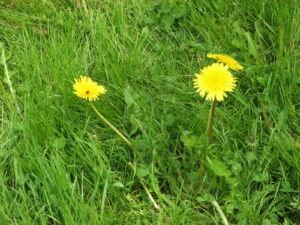Let’s face it: most of us do not have a lawn that looks like the grass on a major league infield. And I for one, don’t want one that does. Most professional ball fields are doctored weekly with chemicals: fungicides, herbicides, fertilizers, insecticides. They are cut very short, and look “perfect”. Yes, I want a lawn that is green, but also full of diversity – clover, different kinds of grass, and (I can see some of you shuddering) even a few dandelions.

Dandelions and clover in the lawn are not bad
The turf grass industry decided long ago that clover is a weed. Why is that? Because the herbicides they promote to control weeds like dandelions and plantain also kill clover – but not grasses. But clover is not a weed. It is a nitrogen-fixing legume that actually adds nitrogen to the soil. It is a friend to your lawn – and your children, who delight in finding good luck with a rare 4-leafed clover. Add Weed-n-Feed and the clover is gone.
So what can you do to have a better lawn when the heat of summer arrives? I talked to Paul Sachs, of North Country Organics, an organic fertilizer company in Bradford, Vermont. Paul has written books about lawn care and soil biology, and really is a very knowledgeable lawn guy. He mentioned several things you can do, first among them: adjust your mower blades up high.
Paul Sachs explained that cutting the lawn at 3 to 4-inches will help to shade the crown of the grass and keep it cooler, which is good. Hot weather stresses most grasses. Taller grass will also develop a deeper root system because the longer blades will produce more food to nurture the roots.
I don’t recommend that you bag the clippings when you mow the lawn. If you are tending your lawn organically (avoiding all chemicals), the clippings will break down, creating a thin layer of compost. Earthworms will turn that organic matter into the soil, too, like little rototillers. The chopped grass will serve to shade the soil a little, helping to reduce heat stress.
The only time I collect the grass clippings is when we get a week or more of hot, rainy weather and I can’t or don’t mow. When there are big lumps of grass, it can smother the grass and turn it yellow, eventually killing it. Fresh grass clippings, added to a compost pile, will add lots of nitrogen and heat up the compost quickly, and helping it to break down the carbon-based brown matter.
If you have bare spots in the lawn, now is the time to plant some grass seed. Do that as soon as you can, as the hot weather ahead will make it harder for new lawn to establish itself. You want to get new grass established before annual crabgrass takes over. The best choice for that is a perennial rye grass, according to Paul Sachs. It germinates quickly – in 5-to7-days.
Start by loosening the soil in the bare spots with a short-tine garden rake. Scratch it back and forth to loosen the soil, and to remove any rocks. Scatter a layer of seed, then use a lawn rake to work it into the loose soil. I turn the lawn rake upside down, so I can drag the back of the tines across the seed. This will cover most of the seed.

Cover seeded areas with straw and water often scaled
You can help your new planting by shaking out some straw over the area, providing a thin layer to shade the soil. It is important that the seed not dry out once it has begun to grow. So if the weather is hot and dry, check the soil every day, and water as needed.
Paul Sachs told me that if you have an irrigation system for your lawn, you can help your lawn by giving it a tenth of an inch of water every day at the heat of the day. That light watering evaporates, cooling the soil and your grass. It’s similar to what we do when we sweat to cool down. Then once a week, he said, give your lawn an inch of water for a deep watering – if we have not gotten that moisture from the sky.
Another way you can help your lawn to grow better and avoid heat stress is to add mycorrhizal fungi to your soil. These fungi work with plant roots in a symbiotic relationship – one in which both organisms benefit. According to Paul Sachs, these are best added at planting time when preparing the soil.
The mycorrhizal fungi coat plant roots and benefit from sugars produced and exuded by the roots. In turn the mycorrhizal fungi breakdown soil minerals and provide needed nutrients to the green plants in a form they can use. Not only grasses benefit from mycorrhizal fungi, most green plants do. Learn more at
https://mycorrhizae.com/. A number of commercial products are available to provide these beneficial organisms, and many are present without treatment.
One last thought: if we could purchase daffodils that would grow in the lawn and re-bloom after mowing, we would pay big bucks for them, right? Especially if they would send out seeds and show up even where we have not planted them. But call them dandelions, and some people declare war. Me? I love those bright harbingers of spring and summer and don’t mind them in my lawn. A diverse lawn is a healthy lawn. I like to say, if it’s green and I can mow it, it’s a lawn!
Henry is now offering workshops on-line using Zoom to garden clubs and library groups. Contact him at
henry.homeyer@comcast.net. He is the author of 4 gardening books.




